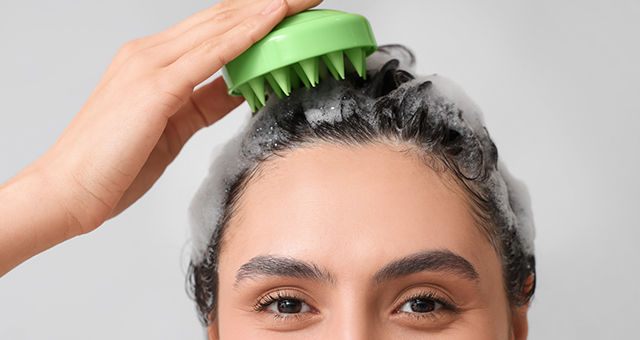
In This Story:
Scalp care is an essential part of maintaining healthy hair and ensuring the growth of strong, thick strands. The scalp is often overlooked in the pursuit of hair that looks a certain way. However, providing the scalp with nourishment is the key to achieving strong, beautiful hair. A healthy scalp has a balanced oil production and resists irritation. Regular scalp care can prevent common hair woes like dryness, dandruff, or greasiness.
Incorporating the right products, such as gentle cleansers and hydrating treatments, can improve scalp health significantly. This is why it’s important to have a good hair care routine. By prioritizing scalp care, you not only enhance your hair’s appearance but also address any underlying concerns that could impact your confidence and comfort.
The skinification of hair care has been a long time coming – and with the advent of this movement, the beauty market has witnessed a noteworthy transition. Today, hair care isn’t confined to caring for your strands but has adopted a more holistic approach that entails addressing your scalp concerns.
What Is Scalp Care, And Why Is It Important?
Fairly self-explanatory, scalp care involves caring for your scalp and tackling specific scalp concerns; it entails cleansing, re-balancing, and moisturising. While our scalp is an extension of our skin, it often doesn’t receive half as much attention, consequently becoming the ‘mane cause’ of our hair woes. A happy, healthy head of hair begins at the roots, which is why holistic hair care is paramount. Just as you follow an AM and PM skincare routine, you must have a scalp care routine, too.
What Does A Healthy Scalp Look Like
Here’s what a healthy scalp looks like:
- Clean and smooth feel with balanced moisture levels.
- Free from visible flakes, redness, or excessive oiliness.
- Hair grows evenly and strands are strong, as follicles function optimally in a well-nourished scalp.
- Slight natural sheen due to proper oil regulation.
- Does not exhibit signs of irritation, such as inflammation or sensitivity
- Consistent hair growth without significant shedding or breakage
How To Know If You Have An Unhealthy Scalp?
Here are some telltale signs of an unhealthy scalp that may indicate underlying problems:
- Consistent dryness with visible flakes and/or dandruff.
- Excessive oiliness and constant greasy feel.
- Constant itchiness, redness, or irritation.
- Unusual hair shedding or slower hair growth as a result of clogged or stressed follicles
- Painful bumps, sores, or scabs that could be a sign of infections or allergic reactions
- Brittle, thinning hair that is prone to breakage
A Step-By-Step Scalp Care Routine For Beginners
1. Scalp Pre-Treatment
In the first step of your scalp care routine, apply Thriveco’s dermatologically-tested Anti-Dandruff Pre-Shampoo Treatment Lotion and gently massage it into your scalp in circular motions. Leave the formulation on for 5-10 minutes before washing it off with shampoo.
2. Detangle and Boost Circulation
Using a scalp exfoliator brush goes a long way in stimulating optimal blood circulation to your follicles. Spend up to five minutes massaging your mane to activate your muscles and allow for deeper penetration of the product.
3. Exfoliate
Just as you exfoliate your skin to buff away dead cells, dirt, and grime, lightly scrub your scalp—every four to six weeks—with Bare Anatomy’s Scalp Scrub. This step is a must for those plagued by excessive dryness, flaking, dandruff, and overall scalp discomfort.
4. Deep Cleanse
The next step of the routine involves employing a clarifying shampoo to adequately cleanse your scalp. Nykaa recommends celebrity-approved Anomaly Clarifying Shampoo, imbued with charcoal and eucalyptus, to help invigorate your follicles and soothe an itchy scalp.
5. Condition
Do not skip conditioner after using a clarifying or detoxifying shampoo. Olaplex’s offering is colour-safe and helps repair and strengthen your tresses after every use.
6. Hydra-Boost
Quench your strands’ thirst with a super-moisturising hair mask, such as MCaffeine’s offering. Their Naked & Raw Cappucino Coffee Hair Mask promises to replenish the moisture in your mane, all while adding a sheen to your tresses.
7. Moisture Lock-In
Finish off with a serum to instantly lock in the moisture in your hair. Aveda’s Scalp Solutions Overnight Scalp Renewal Serum strengthens your scalp’s barrier and fights signs of premature ageing while you sleep.
Key Takeaways
Since environmental stressors and changing weather are often the culprits behind dandruff and scalp irritation, consider indulging in a scalp care routine throughout the year. If you have an oily scalp, opt for formulas boasting tea tree oil, ylang-ylang oil or salicylic acid. Whereas, if you possess a dry and flaky scalp, keep an eye out for ingredients including sulfur, coal tar, zinc, selenium sulfide, and alpha hydroxy acids. Scalp care starts with being consistent, so ensure you’re applying the products for the required amount of time and cleansing your hair regularly to keep the scalp clean and fresh.
FAQs
-
How often should I wash my scalp?
The frequency of washing hair depends on your hair type and scalp condition. Oily scalps may require washing every 1-2 days, while dry or sensitive scalps can benefit from washing 2-3 times a week.
-
What ingredients should I avoid in scalp products?
When it comes to scalp products, avoid the following ingredients:
- Sulfates
- Alcohol
- Heavy silicones
-
Can scalp massage promote hair growth?
Yes! A scalp massage – especially done with oil – increases blood circulation, which stimulates hair follicles and encourages growth while reducing stress.
-
How do I treat dandruff effectively?
To treat dandruff, use medicated shampoos with ingredients like ketoconazole, salicylic acid, or zinc pyrithione. It is also crucial to maintain consistent hydration to prevent build-up and dandruff.
-
Can a poor diet affect scalp health?
Definitely. Nutrient deficiencies, especially in vitamins B, D, and iron, can lead to unhealthy scalp and hair issues.
